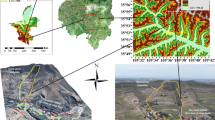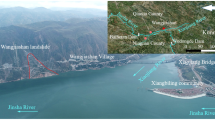Abstract
Understanding the causes of slope development with movement initiation of land sliding requires knowledge on dynamicity, displacement, strain concentration and factor of safety. The 13th mile landslide on Gangtok-Nathula road of the Sikkim Himalaya has seriously affected the Indo-China trade route. To quantify the spatial movement pattern, strain analysis and identification of zones of safety were attempted which indicates that differential movement activity of the landslide zone is co-relatable with differential strain pattern with an overall imprint of the Himalaya collision tectonics.
Similar content being viewed by others
References
Ghosh, S., van Westen, C.J., Carranza, E.J.M., Jetten, V.G., Cardinali, M., Rossi, M. and Guzzetti, F. (2012) Generating event-based landslide maps in a data-scarce Himalayan environment for estimating temporal and magnitude probabilities. Engg. Geol., v.128, pp.49–62.
Morgenstern, N.R. and Price, V.E. (1965) The analysis of the stability of general slip surfaces. Geotechni., v.15, pp.79–93.
Sarkar, K., Singh, T.N. and Verma, A.K. (2010) A numerical simulation of landslide-prone slope in Himalayan region–a case study. Arabian Jour. Geosci., v.5(1), pp.73–81.
Shen, Z.K. and Jackson, D.D. (2000) Optimal estimation of geodetic strain rates from GPS data. EOS Trans. AGU, v.81(19), p.S406.
Shen, Z.K., Jackson, D.D. and Ge, B.X. (1996) Crustal deformation across and beyond the Los Angeles basin from geodetic measurements. Jour. Geophys. Res., v.101, pp.27957–27980.
Singh, T.N., Gulati, A., Dontha, L. and Bhardwaj, V. (2008) Evaluating cut slope failure by numerical analysis–a case study. Natural Hazards, v.47(2), pp 263–279.
Soja, R. and Starkel, L. (2007) Extreme rainfalls in Eastern Himalaya and southern slope of Meghalaya Plateau and their geomorphologic impacts. Geomorpho., v.84(3-4), pp.170–180
Stability Modelling With Slope/W 2007 Student version. An Engineering Methodology, Third Edition, March 2008, GEOSLOPE International Ltd.
Teza, G., Pesci, A. and Galgaro, A. (2007) Grid_ strain and grid_strain3: Software packages for strain field computation in 2D and 3D environments. Computer and Science, v.34, pp.1142–1153.
Terzaghi, K. (1950) Mechanism of landslides. In: Paige (Ed.), Application of Geology and Engineering practice (Berkey Volume). New York, Geological Society of America, pp.83–123.
Author information
Authors and Affiliations
Corresponding author
Rights and permissions
About this article
Cite this article
Hindayar, J.N., Dasarwar, P., Srivastava, S.P. et al. Dynamicity of the Himalayan landslide — A tectono-geotechnical appraisal of the 13th mile landslide, Sikkim. J Geol Soc India 88, 197–205 (2016). https://doi.org/10.1007/s12594-016-0478-6
Received:
Accepted:
Published:
Issue Date:
DOI: https://doi.org/10.1007/s12594-016-0478-6




